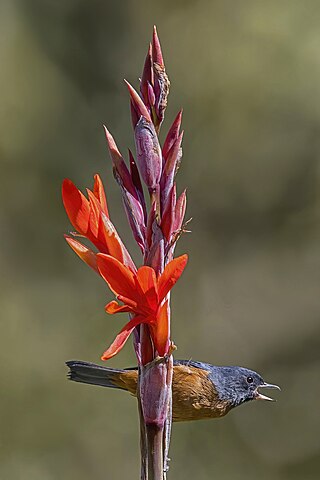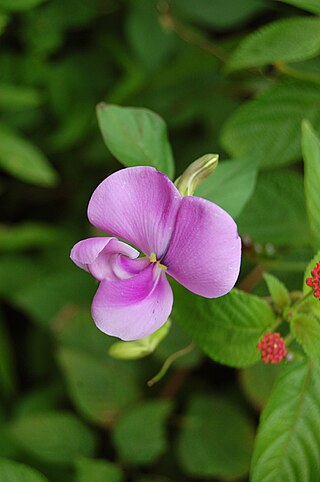
The radish is an edible root vegetable of the family Brassicaceae that was domesticated in Asia prior to Roman times.

Poa pratensis, commonly known as Kentucky bluegrass, smooth meadow-grass, or common meadow-grass, is a perennial species of grass native to practically all of Europe, North Asia and the mountains of Algeria and Morocco. It is a common and incredibly popular lawn grass in North America with the species being spread over all of the cool, humid parts of the United States, despite the fact that it is not native to North America. The Spanish Empire brought the seeds of Kentucky bluegrass to the New World in mixtures with other grasses. In its native range, Poa pratensis forms a valuable pasture plant, characteristic of well-drained, fertile soil. It is also used for making lawns in parks and gardens and has established itself as a common invasive weed across cool moist temperate climates like the Pacific Northwest and the Northeastern United States. When found on native grasslands in Canada, for example, it is considered an unwelcome exotic plant, and is indicative of a disturbed and degraded landscape.

Crotalaria is a genus of flowering plants in the family Fabaceae commonly known as rattlepods. The genus includes over 700 species of herbaceous plants and shrubs. Africa is the continent with the majority of Crotalaria species, which are mainly found in damp grassland, especially in floodplains, depressions and along edges of swamps and rivers, but also in deciduous bush land, roadsides and fields. Some species of Crotalaria are grown as ornamentals. The common name rattlepod or rattlebox is derived from the fact that the seeds become loose in the pod as they mature, and rattle when the pod is shaken. The name derives from the Ancient Greek κρόταλον, meaning "castanet", and is the same root as the name for the rattlesnakes (Crotalus).

Vicia cracca, is a species of flowering plant in the pea and bean family Fabaceae. It is native to Europe and Asia. It occurs on other continents as an introduced species, including North America, where it is a common weed. It often occurs in disturbed habitats, including old fields and roadside ditches.

The winged bean, also known as cigarillas, goa bean, four-angled bean, four-cornered bean, manila bean, princess bean, asparagus pea, dragon bean, is a tropical herbaceous legume plant.

Carissa is a genus of shrubs or small trees native to tropical and subtropical regions of Africa, Australia and Asia. Until recently about 100 species were listed, but most of them have been relegated to the status of synonyms or assigned to other genera, such as Acokanthera.

White mustard is an annual plant of the family Brassicaceae. It is sometimes also referred to as Brassica alba or B. hirta. Grown for its seeds, used to make the condiment mustard, as fodder crop, or as a green manure, it is now widespread worldwide, although it probably originated in the Mediterranean region.

Canna indica, commonly known as Indian shot, African arrowroot, edible canna, purple arrowroot, Sierra Leone arrowroot, is a plant species in the family Cannaceae. It is native to much of South America, Central America, the West Indies, and Mexico. It is also naturalized in the southeastern United States, and much of Europe, sub-Saharan Africa, Southeast Asia, and Oceania.

Crotalaria juncea, known as brown hemp, Indian hemp, Madras hemp, or sunn hemp,धाकटी घागरी, is a tropical Asian plant of the legume family (Fabaceae). It is generally considered to have originated in India.

Heritiera littoralis, commonly known as the looking-glass mangrove or tulip mangrove, is a mangrove tree in the family Malvaceae native to coastal areas of eastern Africa, Asia, Melanesia and northern Australia. The common name refers to the silvery appearance of the underside of the leaves, resembling a mirror to some degree. The strong timber has uses in marine applications and elsewhere.

Frankenia pauciflora, the common sea-heath or southern sea-heath, is an evergreen shrub native to southern Australia. It is part of the Frankenia genus of the Frankeniaceae family.

Gliricidia sepium, often simply referred to as its genus name Gliricidia, is a medium size leguminous tree belonging to the family Fabaceae. Common names include quickstick, mata ratón; cacao de nance, cachanance; balo in Panama; piñon Cubano in the Dominican Republic; madreado in Honduras; kakawate in the Philippines; madre xacao, madre cacao, or madre de cacao in the Philippines and Guatemala; madero negro in Nicaragua; undirmari in Marathi; pathal or semmakonna in Malayalam and wetahiriya in Sinhala). It is an important multi-purpose legume tree, with a native range from Mexico to Colombia, but now widely introduced to other tropical zones.

Spathoglottis plicata, commonly known as the Philippine ground orchid, or large purple orchid is an evergreen, terrestrial plant with crowded pseudobulbs, three or four large, pleated leaves and up to forty resupinate, pink to purple flowers. It is found from tropical and subtropical Asia to Australia and the western Pacific including Tonga and Samoa.

Wrightia tinctoria, Pala indigo plant or dyer's oleander, is a flowering plant species in the genus Wrightia found in India, southeast Asia and Australia. It is found in dry and moist regions in its distribution. Various parts of the plant have been used in traditional medicine, but there is no scientific evidence it is effective or safe for treating any disease.

Alnus serrulata, the hazel alder or smooth alder, is a thicket-forming shrub in the family Betulaceae. It is native to eastern North America and can be found from western Nova Scotia and southern New Brunswick south to Florida and Texas.

Canavalia cathartica, commonly known as maunaloa in the Hawaiian language, is a species of flowering plant in the legume family, Fabaceae. The Hawaiian name translates as long mountain. In English it may also be known as poisonous sea bean, ground jack bean, horse bean, silky sea bean or wild bean. It has a Paleotropical distribution, occurring throughout tropical regions in Asia, Africa, Australia, and many Pacific Islands, and extending just into subtropical areas. It is not native to Hawaii, and is an invasive species there.

Sterculia foetida is a soft wooded tree that can grow up to 35 metres tall. Common names for the plant are the bastard poon tree, Java olive tree, hazel sterculia, wild almond tree, and skunk tree.

Crotalaria retusa is a species of flowering plant in the legume family known by various common names including devil-bean, rattleweed, shack shack, and wedge-leaf rattlepod. It is poisonous to livestock, and contaminates human food. Its original native range is unclear, probably including tropical Asia, Africa and Australia. It has been introduced as a crop plant in many tropical areas and has escaped from cultivation to become a troublesome weed; it is listed as a noxious weed in several US states, Puerto Rico, the Virgin Islands, and is listed as an invasive weed in India, Cuba, and Cocos Island. Unlike some other species of Crotalaria, it is an annual plant.

Vigna vexillata, the Zombi pea or wild cowpea, is a variable, perennial climbing plant that is pantropical, found in regions such as Ethiopia, Nigeria, and Venezuela.

Pittosporum ferrugineum, commonly known as the rusty pittosporum or rusty-leaved pittosporum, is an evergreen plant in the family Pittosporaceae native to Malesia, Papuasia, the Northern Territory and Queensland.




















